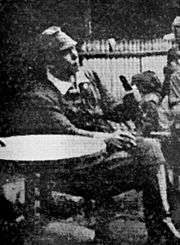Takeo Itō
Takeo Itō (伊東 武夫, Itō Takeo, 6 July 1889 – 24 February 1965) was a general in the Imperial Japanese Army during World War II.
Takeo Itō | |
|---|---|
 Japanese General Takeo Itō | |
| Native name | 伊東 武夫 |
| Born | July 6, 1889 Fukuoka prefecture, Japan |
| Died | February 24, 1965 (aged 75) Japan |
| Allegiance | |
| Service/ | |
| Rank | Lieutenant General |
| Commands held | IJA 38th Division |
| Battles/wars | |
Biography
Takeo Itō was born in the city of Fukuoka in the Fukuoka prefecture[1] The commanding officer of the IJA 228th Infantry Regiment at the start of the Second Sino-Japanese War, he assumed command of 114th Infantry Regiment in August 1940.[1] Upon attaining the rank of major general on August 25, 1941, Itō was given command of the IJA 38th Division's infantry group,[1][2] which was the primary Japanese division in the invasion of Hong Kong.[3]
In early 1942, Itō was reassigned to an independent command in his own name, the "Itō Detachment", consisted mainly of 228th Infantry Regiment, 38th Infantry Division and the 1st Kure SNLF, which took part in the Battle of Ambon[4] in the Dutch East Indies (30 January–3 February 1942), and in the occupation of Timor. All of these campaigns were characterized by extreme ruthlessness and the massacre of prisoners.[5]
In November, Itō, along with one regiment of the 38th Division, was shipped to Guadalcanal. On 11 November, during the pivotal Battle of Guadalcanal, Itō was positioned by Lieutenant-General Harukichi Hyakutake to attack Marines under the command of United States General Alexander Archer Vandegrift who were involved in the Matanikau offensive against Japanese positions. However, Vandegrift called off his offensive that day after receiving intelligence reports of Hyakutake's plans. Itō later helped command 38th Division troops during the Battle of Mount Austen, the Galloping Horse, and the Sea Horse. He and the 38th's survivors on Guadalcanal were evacuated by the Japanese navy during the first week of February 1943. Itō became commander of the 40th Independent Mixed Brigade, stationed at New Ireland on 8 July 1944.[1] He was promoted to lieutenant-general on November 26 of that year.
At the end of the war, Itō was taken into custody by Australian forces, and was tried as a war criminal in a military tribunal for the murder of Chinese civilians. He was sentenced to death at Rabaul, New Britain on 24 May 1946.[6] However, Ito was released on 28 October, and sent to Hong Kong. In 1948, Itō was accused of war crimes at the Hong Kong's War Crimes Court, found guilty and sentenced to 12 years in prison.[7][8] He died on 24 February 1965.
Notes
- L, Klemen (1999–2000). "Major-General Takeo Ito". Forgotten Campaign: The Dutch East Indies Campaign 1941-1942. Archived from the original on 2012-03-10.
- Lai, p. 13
- Ammentorp, Steep. "Ito, Takeo". The Generals of World War II.
- L, Klemen (1999–2000). "The Japanese Invasion of Ambon Island, January 1942". Forgotten Campaign: The Dutch East Indies Campaign 1941-1942. Archived from the original on 2012-12-03.
- Budge, Kent. "Takeo Ito". Pacific War Online Encyclopedia.
- Some Noteworthy War Criminals Archived 2009-03-09 at the Wayback Machine Source: History of the United Nations War Crimes Commission and the Development of the Laws of War, United Nations War Crimes Commission (London: HMSO, 1948)
- Suzannah Linton (26 September 2013). Hong Kong's War Crimes Trials. OUP Oxford. pp. 99–. ISBN 978-0-19-964328-8.
- "前哨之外:再聽不見 妻子的聲音 沒入日軍槍聲的香港 一個失去妻子的軍人". Ming Pao. 2016-08-09.
References
- L, Klemen (1999–2000). "Forgotten Campaign: The Dutch East Indies Campaign 1941-1942".
Further reading
- Chapter VIII:Advances Towards Kokumbona in United States Army in World War II: The War in the Pacific - Guadalcanal: The First Offensive by John Miller (United States Army Center of Military History, 1949 & 1995), pp. 196, 201-202, 204
- Pearl Harbor to Guadalcanal: History of U.S. Marine Corps Operations in World War II, by Lt. Col. Frank O. Hough, USMCR; Maj. Verle E. Ludwig, USMC; Henry I. Shaw, Jr. (Historical Branch, G-3 Division, Headquarters, U.S. Marine Corps) Volume I, Chapter 8: Critical November
- The Hong Kong Society of Wargamers: "The Fall of Hong Kong, Christmas 1941", by Andrzej Cierpicki
- Benjamin Lai: Hong Kong 1941–45, First Strike in the Pacific War, Osprey Publishing 2014, ISBN 978-1-78200-268-0